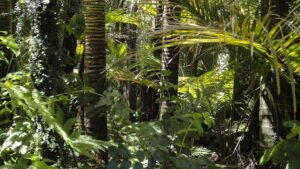
AMERICAN ASSOCIATION FOR THE ADVANCEMENT OF SCIENCE (AAAS)—A dense system of pre-Hispanic urban centers, characterized by constructed platforms and plazas and connected by large, straight roads, has been discovered in the upper Amazon, according to a new study*. The research, based on more than 20 years of interdisciplinary research, suggests that this original 2500-year-old society constitutes the earliest and largest low-density agrarian urbanism documented in the Amazon thus far. Such extensive early development in the Upper Amazon resembles similar Maya urban systems in Central America. Although a growing body of research has begun to highlight the scope and scale of pre-Hispanic occupation of the Amazon, evidence for large-scale urbanism has remained elusive. Stéphen Rostain and colleagues present evidence for an agrarian-based civilization that began more than 2500 years ago in the Upano Valley of Amazonian Ecuador, a region in the eastern foothills of the Andes. Based on more than 20 years of interdisciplinary research that included fieldwork and light detection and ranging (LIDAR) mapping, Rostain et al. describe urbanism at a scale never before documented in Amazonia, consisting of more than 6000 anthropogenic rectangular earthen platforms and plaza structures connected by footpaths and roads and surrounded by expansive agricultural landscapes and river drainages within the 300 square kilometer survey area. The authors identified at least 15 distinct settlement sites of various sizes based on clusters of structures. However, according to Rostain et al., the most notable elements of this built environment are the extensive and complex regional-scale road network connecting urban centers and the surrounding hinterland. Archaeological excavations indicate that the construction and occupation of the platforms and roads occurred between ~500 BCE and 300 to 600 CE and was carried out by groups from the Kilamope and later Upano cultures. Rostain et al. note that the Upano sites are different from other monumental sites discovered in Amazonia, which are more recent and less extensive. “Such a discovery is another vivid example of the underestimation of Amazonia’s twofold heritage: environmental but also cultural, and therefore Indigenous,” write Rostain et al. “…we believe that it is crucial to thoroughly revise our preconceptions of the Amazonian world and, in doing so, to reinterpret contexts and concepts in the necessary light of an inclusive and participatory science.”
Article Source: AAAS news release
*Two thousand years of garden urbanism in the Upper Amazon, Science, 12-Jan-2024. 10.1126/science.adi6317
Cover Image, Top Left: Credit Rosinakaiser, Pixabay
_____________________________
Advertisement

See the incredible archaeology, architecture, and art of northern Spain. A unique tour with special expert guides and lecturers through the collaboration of Popular Archaeology Magazine and Stone & Compass Tours. Not to be missed. Read More About It: https://popular-archaeology.com/article/northern-spains-triple-a-archaeology-architecture-and-art/.
_____________________________





